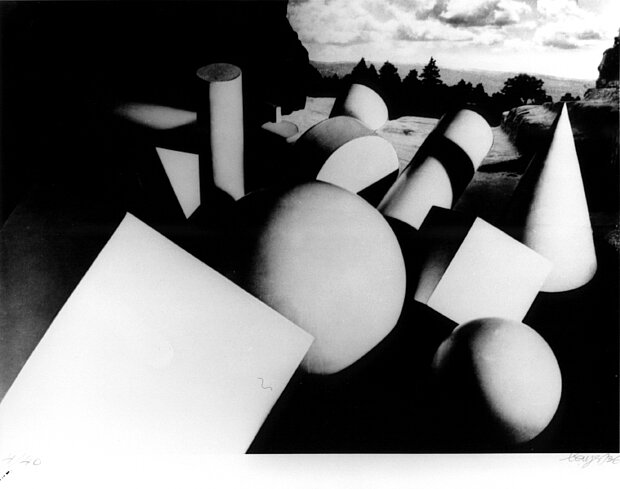
Bayer, Herbert
Metamorphosis
1936

© mumok
| Object description | b/w photograph |
|---|---|
| Object category | sculpture |
| Dimensions |
Objektmaß:
height: 28 cm,
width: 35,4 cm
|
| Year of acquisition | 1971 |
| Inventory number | L 243/4 |
| Creditline | mumok - Museum moderner Kunst Stiftung Ludwig Wien, Leihgabe der Artothek des Bundes |
| Rights reference | Bildrecht, Wien |
| Further information about the person | Bayer, Herbert [GND] |
A photograph that does not look like a photograph. Geometrical forms in sharp black and white contrasts, spread over an undefined space. In the background the outline of a landscape. And in the foreground? What is that rectangular object? The illuminated pictures of Herbert Bayer do not show reality. The title “Metamorphosis” refers to the essence of Bayer’s photography. The artist utilizes optical processes in order to show objects in a different and seemingly supernatural state. He composes with shadow and light, the foreground and the background, three dimensions and two. But nothing remains as it is in reality, nothing is “depicted.” Bayer superimposes, uses double exposure, and processes his photos in the darkroom to create special effects. The result might be a surreal and dreamlike scene in which what looks like a real landscape is confronted with abstract geometrical shapes. The word “photography” has a Greek origin meaning “to draw with light.” What Herbert Bayer did in this work of 1936 goes beyond mere drawing. He created what he called “photo sculptures,” experimenting intensively with the technique of photomontage since the early 1930s. He became a key proponent of a constructivist and surrealist movement in German avant-garde photography. Bayer was inspired by many different fields in his artistic work. He worked as a painter, graphic artist, and exhibition designer. He had to leave Germany in 1938 and emigrated to the USA. Here he continued the teaching work he had begun at the Bauhaus, also working at the Black Mountain College. He was a successful advertising graphic designer and set new standards in the fields of layout and font design—this work still shapes graphic design in the media to this day.
© mumok – museum moderner kunst stiftung ludwig wien